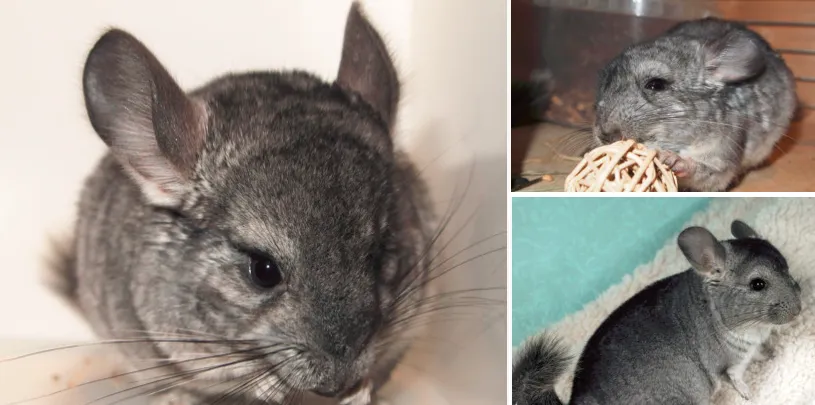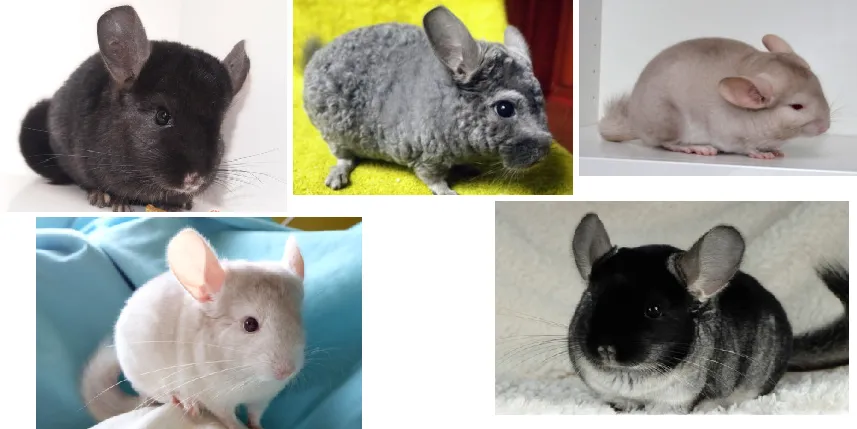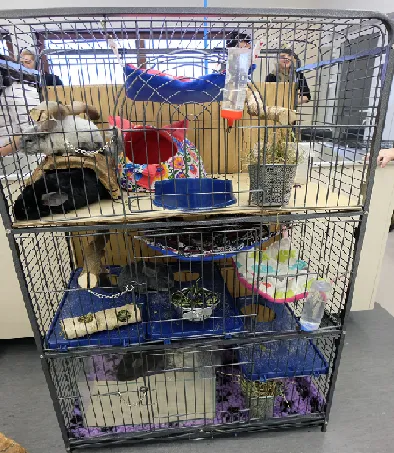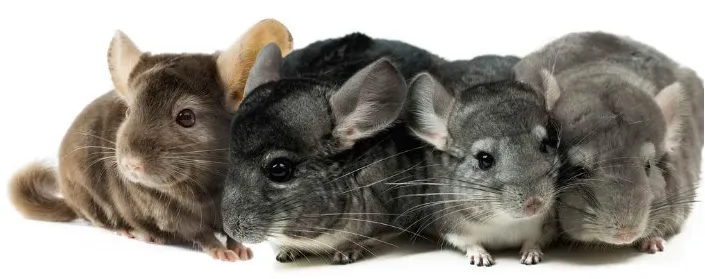
Occurrence
They inhabit the wilderness range of Chilean highlands at an altitude of 300-1500 m above sea level. Numerous hunts for obtaining fur from them led almost to the extermination of chinchillas from their natural environment. Currently, they live exclusively in the Las Chinchillas National Reserve in Chile and in 42 colonies in its vicinity. Small Chinchilla is classified as critically endangered species.
Length of life
In this field chinchillas are real rodent record holders. Their lifespan may exceed 20 years. The longest living chinchilla was 29 years old. Rarely, however, chinchillas live to even half of this length. The most common causes of premature death are injuries (stepping, crushing), complications of dental disease or infections of the respiratory system.
Look
The appearance of a chinchilla resembles a squirrel or a rabbit. He has a stocky body, a shapely, round head set on an almost invisible neck. The relatively long tail is covered with bony hair and slightly raised. The feet are finished with four fingers - three are on the front and one on the back. The front legs, slightly shorter than the back ones, have four function fingers and one finger used less often. The ears are shapely, rounded. The coat is thick and fluffy, in the wild chinchilla of the "agouti" coat - in breeding it is referred to as "standard" -unitarian, dark gray on the back, light gray on the sides and white on the stomach.
Due to the shape and length of the hair, chinchillas can be divided into classical varieties, angora (much longer fur) and curly (curly fur).
Body length of an adult is 260-270 mm (without the tail). Body weight ranges from 400 to 700 grams. The tail consists of 23 vertebrae. It is about 15cm long.
Denture pattern of adult chinchilla: 1013/1013. The choppers have a characteristic yellow color. White color can mean food shortages. Chinchilla teeth grow throughout their lives. Between the incisors and the cheek teeth there is a large gap - diastema.
Color varieties

Dominant varieties
standard - gray with a white belly
beige Tower heterozygous - dark beige with white belly
beige Tower homozygous - light beige with white belly
black velvet - black with white belly
white Wilson - white, with black ears and eyes, can have gray (mosaic) or black (mosaic extreme) patches
ebony - there is a distinction between "sub-varieties" depending on how the dark fur has a chinchilla:
light ebony - light gray, similar to the standard version, however, the belly is gray, not white
ebony medium - dark gray with light
dark ebony clearance : black with bright
extra lumens dark ebony - uniform black on the whole body
Recessive varieties
- purple - dark purple with a snow-white belly
- sapphire - gray-blue with white belly
- black pearl - jet black ridge, snow-white belly, similar to black velvet
Examples of interchange combinations:
- pink white - a variety with the genes of Beige Tower and white Wilson genres; analogously to white Wilson can have light and dark patches in beige / brown; we distinguish hetero- and homozygous pink white (similar to beige Tower)
- brown velvet - a combination of black velvet having the TOV (Touch of Velvet) gene and beige Tower
- tan - also called "beige ebony" - ebony analogue however, gray and black is replaced with beige and brown
- ebony TOV - Connection varieties of ebony with a variation of black velvet
- white ebony - ebony combined with a variety of white Wilson
- blue diamond - Connection DWO ch varieties recessive: violet and sapphire
We distinguish a lot of inter-variation combinations, so only a very good knowledge of the chinchilla genetics will allow for the exact determination of the color variation including the so-called "Carriers" of the gene (carrier), ie heterozygous individuals that carry recessive genes and can give offspring of the recessive variety, although they do not resemble phenotypically.
Chinchillas in nature
They are very energetic and skittish animals. They have a well-developed organ of hearing and smell. They lead a nocturnal lifestyle. In the wild, they inhabit narrow rock fissures, burrows, where they build nests on a sandy or gravel substrate, lined with fibers from the leaves of local plants , most often a plant called "puya" there, which is also their main food . They eagerly eat grass leaves , less willingly branches of shrubs. In the natural environment, water is obtained from the morning dew, and they also collect it along with the eaten plants.
Chinchillas at home
The beginnings of breeding take place in 1921 when 12 chinchillas arrived in California. All currently bred animals come from this small cluster. Chinchillas are herd animals, therefore they should be in a cage with another individual. Keeping them alone is conducive to the problem of biting fur. If we do not plan breeding (this applies especially to individuals of unknown origin and too low weight), it is recommended to keep herds of same-sex animals. Chinchillas belong to animalspure. While maintaining hygiene, they do not give off an unpleasant odor. They also do not like moisture, so they are usually reluctant to stay on the owners' hands and rarely allow them to be petted. They do not often bite, but some aggressive females may try to scare away a man by standing on his back paws and spurting urine. They are very mobile, therefore, in addition to a high cage with numerous shelves should be ensured safe run. Their diet and living conditions are similar to those of degus, which is why they are sometimes kept together. However, it should be remembered that degus, as opposed to chinchillas, lead a daily lifestyle, so they can interfere with each other.
Chinchillas can be very aggressive in relation to other, previously unknown, chinchilla, therefore the correct joining process should be carried out, so that one of the specimens will not be damaged and mutilated. This applies to both mixed and same-sex couples.
Due to the fact that they are noisy animals , people who have a light sleep, should not set the cage in the bedroom. The place where the cage stands should be quiet and cool. Temperatures above 25 ° C pose a risk of heat stroke in these animals . Chinchillas tolerate low temperatures much better. They are able to get used to a temperature slightly higher than that0 ° C, and at less than 10 ° C, the growth of the hair coat is intensively stimulated. It is important that the selected place is devoid of drafts. The surrounding walls and valuable items should be secured, because they will undoubtedly be treated with urine even by a very harmonious herd of chinchillas. Anything that is within the reach of their teeth will also be destroyed. Do not keep or put chinchilla outside because of their overheating or cold.
Room

Regardless of whether it will be a wooden aviary or a metal cage with a plastic litter box, the basic rule is its vertical arrangement. It should be high, with lots of shelves. The minimum dimensions for two chinchillas are: 40 × 60 cm base and 100 cm height. The shelves must be full, because the net supports foot damage. The fleece hammocks and cottages are also very popular with chinchillas. Placing branches, for example from willow, is an additional attraction for animalsthat can bite them and walk on them, and what's more, it prevents the formation of corn on the feet. You can easily teach them to pee into a cuvette, but you should be aware of the fact that numerous litter boxes will be scattered both inside and around the cage. Bowls can be metal screwed, and ceramic (these should not be put on the upper shelves, because it is possible to throw it on the head of another chinchilla). The plastic or glass stopper must be protected in such a way that it does not fall or be chewed. The equipment of the cage must also include pasture for hay and temporarily placed inside a swimming trunk with volcanic dust or other suitable for chinchillas sand. Do not use sand for birds, because it contains quartz, which destroys the hair coat of chinchillas. It is a great idea to put a wooden disk or full body reel in the cage, but its diameter can not be less than 40 cm. Wooden toys for biting are great entertainment for these creatures.
nourishment
The basis for the chinchilla diet is hay, preferably from at least several grass species. Another equally important element are dried herbs and twigs of trees (eg apple, willow, birch, pear, currant, hazel, lime). The list of herbs available for feeding for chinchillas is very long. These include dandelion, plantain and lanceolate, stinging nettle, horsetail, mallow, hibiscus, calendula, lemon balm, echinacea. Hay, herbs and twigs are very often eaten by chinchillas, and this in turn prevents the occurrence of diseasesdental. Avoid using feed mixtures because commercial commercial mixtures contain a large amount of cereals, vegetables and fruits, and these adversely affect the health of chinchillas. So it would be ideal for granulated without grain, made only from grasses and herbs. An additional criterion when choosing a food is the granule structure - it should be in the form of pellets, not inflated crisps. Pellet is rubbed by a chinchilla, which favors cheek teeth. The crisps are crushed, causing microunds of the tops of the cheek teeth to form at the alveolus. This promotes inflammation of teeth tips and the area. On the Polish market, there is currently no ideal chinchilla food, therefore its possible use in the diet should be as limited as possible. Treats,
Chinchillas are quite resistant to lack of water, but should have constant access to it in the cage. During long trips, it is recommended to take breaks and give him water or place a small piece of fresh apple at this time.
Care
The sand or volcanic dust mentioned above is used to clean the fur. Sand baths should be carried out at least twice a week, placing the swimming trunk for about half an hour inside the cage or on the floor during catwalks.
Health
The chinchilla's health problems most often result from the abnormal maintenance of these animals . A big problem, like guinea pigs, rabbits or deglots, are dental diseases whose complications can lead to death. The characteristic symptoms are abundant COG molting to a drastic decrease in weight of the animal, taking willing food for mouth and then spitting it rubbing paw snout. Another very frequent complaint, especially in autumn and winter is skin tinea. The rapid implementation of the treatment ensures its good effectiveness. Maintaining immunity at a high level protects the body against dermatophytosis, so stress related to transport, joining new individuals and other stressful situations in autumn and winter should be avoided. The most widespread parasitosis among chinchillas is giardiosis . It is caused by a protozoon of the genus Giardia spp. , Which lives in the small intestine of chinchillas, mainly in the duodenum. In 99% of cases it is asymptomatic. In the case of a significant decrease in immunity or the appearance of an infectious agent, it may complicate the course of the disease . Due to the high mobility of these animalsit is not difficult for them to get hurt. Stepping on or bruising in the worst case can result in the death of chinchillas, and often the fracture of the paw bone occurs . If you suddenly change your diet, give a lot of fresh fruit, bad water and if infectious agents are present, you may get diarrhea . Intense diarrhea lasting longer than 3 days can cause death of such a small organism, because it quickly gets dehydrated. Infections of the respiratory systemthey are also very dangerous because they quickly include the lungs, so avoid drafts where the chinchilla is. Because of the thick fur, chinchillas can not tolerate high temperatures. A longer stay at temperatures above 30 degrees may lead to dehydration and heat stroke in these animals . The symptom of heat stress is redness of the ears, frequent relying on the side, panting, yawning, aversion to movement.
Multiplication
The pregnancy of chinchilla lasts 111 days (+/- 3 days). Childbirth before day 105 is considered a miscarriage, and babies soon die because of their internal organs that are not fully developed. Sexual maturity of chinchillas is between 4 and 6 months old, but breeding maturity is only at 8 months, which means that only then can they be allowed to reproduce at the earliest. Their weight is also important. For breeding should be used only males with a minimum weight of 500 grams, and females - a minimum of 600 grams. The exception is the sapphire variety, in which the average weight of adult chinchillas is 350 grams, and attempts to enlarge these individuals were associated with the loss of a beautiful, blue shade of fur. This variety, however, is a huge rarity in breeding. Another factor necessary for running a professional breeding is knowledge of originanimals . Chinchillas for breeding are best obtained from other professional farms that keep records of their ancestors and together with the sale of an animal they issue the so-called certificate to the buyer. The information that should be contained in this document is: data on the animal (date of birth, color variety, gender, identification number or first name) and a family tree with the same data of parents and grandparents. Unfortunately, at the moment, there is no connection for domestic chinchillas, so there is no verification of data provided by breeders in the birth certificates. In this matter, you should rely only on the opinions about the breeding, from which we plan to buy animals and believe that the person can be trusted.
Rui on chinchill takes about 4 days and occurs every 30-45 days. It is also important to distinguish postpartum bum that lasts over two weeks and occurs (as the name suggests) immediately after giving birth. In this heat, the chinchilla may also get pregnant again, but it is associated with a huge burden on the female body, which may translate into low birth weight of the young, difficult delivery or even death of chinchillas at birth. In order not to burden the organism significantly and extend the breeding capacity of the animal, it is recommended to detach the male before delivery and re-attach it at least 3 weeks after the birth of the young. The next rune after childbirth occurs most often 50 days after delivery. Fertilization during this period also allows you to easily calculate the date of birth of the toddlers.
Copulation lasts for a short chinchilla (a few dozen or so seconds) and usually occurs during the night hours. So there is no way to "guard" a pair of chinchillas before getting pregnant. After successful copulation the so-called "post-poplar post" is expelled. It is not 100% confirmation of fertilization, but it may allow us to calculate the exact date of birth if, however, to such a date. Sometimes a similar spigot is excreted by a female with intense heat.
Diagnosis of early pregnancy in chinchilla is currently very difficult. Skilled breeder is able to recognize her only between 40-50 days, and often only after 60. It is most often diagnosed by touching the female, however, untrained hands can damage the fetuses and as a result - miscarriage, which is why you should perform a test with a giantcaution and as short as possible. Ultrasound examination can detect pregnancy only after the 60th day. It is extremely important to regularly weigh chinchilla, preferably once a week. The female starts gaining weight at different times of pregnancy, and the average weekly gain is 15 grams. The pregnant diet should be varied, rich in protein and calcium. The subject of feeding chinchillas is still explored and undoubtedly constitutes a very extensive department in the breeding of these animals .
The heralds of the coming birth are:
- fetal movements - fist kicks are visible when the whole hand is applied; appear on the 3,5 week before delivery
- frequent relying on the side or on the back - 2-3 weeks before delivery
- aggression towards a male or other individuals - the female should be separated when this behavior occurs , but it is not a rule - sometimes it is possible to leave a pregnant woman in the group of other females that later take care of offspring together
- weight loss - for a week or two before giving birth chinchilla may lose much appetite; this is a natural behavior, however, very dangerous in infected animals (too much fat, analogous to the Fatty Cow)
- Swelling and redness of mammary glands - some appear 4 days before delivery, while others only one day before; milk is also present in mammary glands daily before delivery
- abdominoplasty - loosening the ligaments of the uterus results in the abdomen dropping, which causes the skin to collapse just below the transverse processes of the lumbar spine; appears the day before delivery
- opening of the genital tract - day before delivery
Newborns usually come into the world in the early morning, usually 1-2, less often 3 or more. They are bullets, which means they are covered with fur, they have their eyes open and they start walking immediately. Their weight ranges from 30 to 70 grams. Weight below 30 grams is considered critical and may indicate a poor condition of the female during pregnancy or incomplete development of the baby. The weight of newborns should be monitored every day for a minimum of 3 weeks. Later, you can extend the measurement time to one in two or three days. A small decrease in body weight in the first two days is considered to be physiological, however, it should be observed at this time whether the young take milk. If there is a need to feed the newborn (death of the mother, rejection, aggression on the part of siblings) can be done by feeding goat's milk (temperature about 30 ° C) initially every 2 hours (also at night) in a volume of 2-4 ml and gradually increase volume every few days while reducing the frequency of meals. They start to take their new solid food as early as the first week of life, but initially it accounts for only 10% of the total dietary intake, but increases over time. The young are ready to leave the farm at the age of 3 months and weighing a minimum of 300 grams. Chinchillas take milk for 2 to 2.5 months of age, and too fast separation from the mother translates into weak later their increments. They start to take their new solid food as early as the first week of life, but initially it accounts for only 10% of the total dietary intake, but increases over time. The young are ready to leave the farm at the age of 3 months and weighing a minimum of 300 grams. Chinchillas take milk for 2 to 2.5 months of age, and too fast separation from the mother translates into weak later their increments. They start to take their new solid food as early as the first week of life, but initially it accounts for only 10% of the total dietary intake, but increases over time. The young are ready to leave the farm at the age of 3 months and weighing a minimum of 300 grams. Chinchillas take milk for 2 to 2.5 months of age, and too fast separation from the mother translates into weak later their increments.
Gender recognition is very easy even for one-day-old babies. The distance between the urethral meatus and the anus is significant in males, while in females the estuaries are located next to each other.
